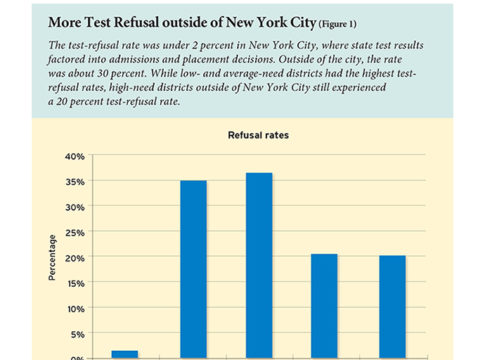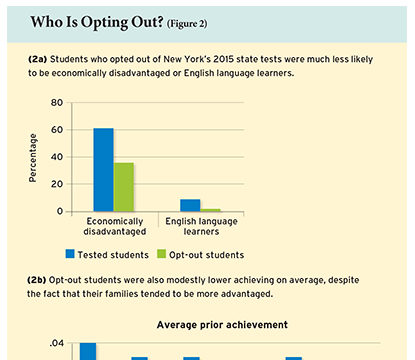New analyses of opt-out movement offer fresh perspectives
Although less likely to be economically disadvantaged, opt-out students tended to be lower-achieving than test takers in New York State last year
June 16, 2016—Testing has become an increasingly contentious issue in recent years, with students by the thousands refusing to take annual standardized tests, a movement that is putting more than a dozen states at risk of losing Title I funds. To make sense of the opt-out phenomenon, Education Next spoke with two public school parents: Scott Levy, a local school board member in New York State, and Jonah Edelman, cofounder and CEO of Stand for Children.
Levy believes that the large number of test refusals in New York State is a symptom of legitimate parental concerns resulting from the negative unintended consequences of the roll out of Race to the Top and the Common Core. Using data provided by the NYS Department of Education, Levy calculates that over 225,000 students opted-out of New York’s 2015 state tests: about 20 percent of eligible students in grades 3-8. Levy notes that the opt-out rate reached 30 percent outside of New York City, where the opt-out rate was under 2 percent. Parents viewed the linkage of test scores to teacher evaluations as highly controversial and were also concerned with test quality, transparency and length. For 3rd graders, the length of the ELA and math tests grew by 163 percent between 2010 and 2014. Last year, some elementary schools took up to 540 minutes to test students, more than double the length of the SAT.
Edelman, a school reform advocate, views testing as one mechanism by which teachers and parents can measure student progress, and policymakers can identify areas of inequity, failing schools, and racial achievement gaps. According to new data, although students who opted out of tests in New York State in 2015 were much less likely to be economically disadvantaged or English language learners, they also tended to be modestly lower-achieving than those who took the test. Edelman emphasizes that testing is the best way to gauge student learning: “Just because a student attends an advantaged school does not mean that he or she is automatically on track for college or career,” he says.
Early reports suggest that the New York State test refusal rate has remained high in 2016. Levy says that policymakers have begun to address parents’ criticisms, but the length, transparency, and quality of the exams are still of serious concern. “All constituencies must work together to construct a fair and effective system of assessment that supports teaching and learning rather than disrupting it,” says Levy.
To receive an embargoed copy of “Making Sense of the Opt-Out Movement” or to speak with the authors, please contact Jackie Kerstetter at jackie@alessicommunication.com. The article will be available Tuesday, June 21 on www.educationnext.org and will appear in the Fall 2016 issue of Education Next, available in print on August 29, 2016.
About the Authors: Scott Levy is a New York State local school board member. Jonah Edelman is the cofounder and CEO of Stand for Children, a national organization advocating for college- and career-readiness for all.
About Education Next: Education Next is a scholarly journal committed to careful examination of evidence relating to school reform, published by the Hoover Institution at Stanford University and the Harvard Program on Education Policy and Governance at the Harvard Kennedy School. For more information, please visit www.educationnext.org.





